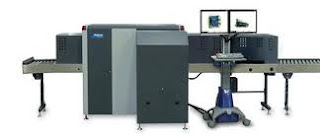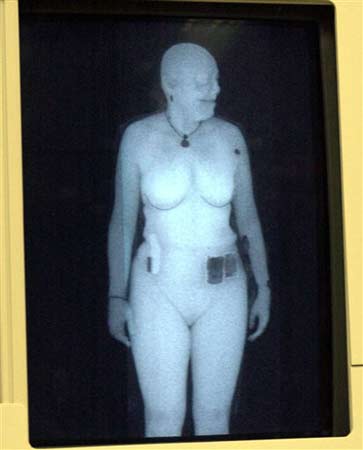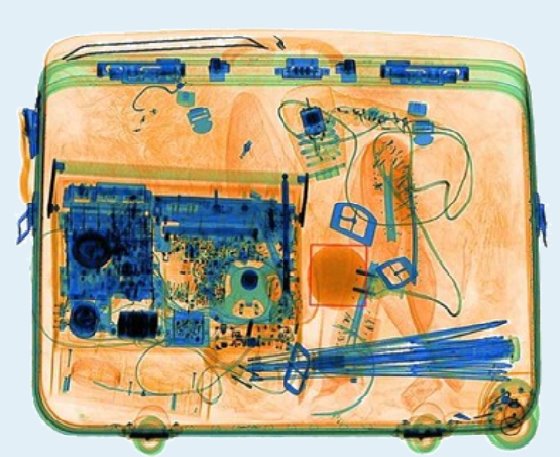- Multiple-Beam X-ray scanners
- Baggage Scanner Manufacturing Companies
- Watch Airport CT Scanner Systems
- FACTS ABOUT BODY SCANNER
- Computed Tomography for Airport Security
- Combined Test Piece
- Common Baggage X-Ray ABBREVIATIONS
- X-Ray Baggage Inspection system technical specification
- CT image of a Bag
- Film Safe
- Radiation Levels
- Explosive Sniffing Dogs
- Explosive Trace Detection Machines
- Automated X-ray Machines
- EDS Machines
- All About X-RAY DETECTOR
- BCAS INDIA WEBSITE
- XBIS NEWS
Classification of XBIS based on the performance to Detect LEDS
Type A: the LEDS screens individual
containers and requires containers to be opened for sampling. LAG containers must
be removed from cabin baggage.
Type B: the LEDS screens individual
containers with no requirement for containers to be opened (original seal remains
intact). LAG containers must be removed from cabin baggage.
Type C: the LEDS screens multiple
containers with no requirement for containers to be opened (original seal remains
intact). LAG containers must be removed from cabin baggage.
Type D: the LEDS screens LAG containers
with no requirement for containers to be opened (original seal remains intact).
LAG containers do not need to be removed from cabin baggage.
Type D+: the LEDS is additionally capable
to screen LAG containers with complex electronics (e.g., laptops) present in
cabin baggage.
Computed Tomography for Airport Security
Watch Computed Tomography (CT) for Airport Security
In Computed tomography (CT) system two-dimensional x-ray
images through an object are taken and added together to produce three-dimensional
image. The effective atomic number is calculated and materials with the same Z
number as explosives can be identified
Combined Test Piece.
The STP or CTP is used to ensure that the performance requirements for X-ray machines set out are met and maintained.Some times it is called Combined Test Piece (CTP) .The STP contains samples of organic and inorganic material, materials for resolution and penetration tests.
SINGLE WIRE RESOLUTION (TEST No.1)

SINGLE WIRE RESOLUTION (TEST No.1)
A set of un-insulated tinned copper
wires of size 26, 30, 35, 38, 40 and 42 SWG or corresponding AWG wires are placed on Perspex sheet. The
wires are laid out in 'S" shaped curves.
The wires are placed behind varying thickness
of aluminium. A quarter of the length of each wire is uncovered whilst the
remaining 3 quarters are covered by 3 wedges of aluminium, corresponding to
4.8mm (3/16"), 7.9mm (5/16") and 11.1mm (7/16") thickness. The minimum requirement
is to display 40 SWG wire not covered by step wedge for most of the machines. Metallic marker should be provided using
high-density material, so that SWG numbers in the Display are clearly visible.
USEFUL
PENETRATION (TEST No.2)
Defines what level of details can be seen behind a thickness
of known material. The requirement of this test is that the 26 SWG wire is seen
under step wedge of 5/16 thickness of Aluminium.
MULTI ENERGY X-RAY (TEST No. 3)
With multi-energy X-Ray, it should be possible to distinguish
between materials of different average atomic number. The use of sugar and salt
samples encapsulated on the test piece of CTP will check the material
discrimination facility. A different color of sugar and salt on display indicate that the sugar/salt samples are
shown in different color.
SIMPLE PENETRATION
(TEST No. 4)
This test defines what thickness of steel the machine should
be able to penetrate. The steel step wedge on the CTP has steps of 2 mm from 20
mm to 40 mm with a lead strip, 1.5mm in thickness to check that the machine is
above or below the requirement. The requirement will be different for different
KV machines.
SPATIAL RESOLUTION
(TEST No. 5)
This test defines the ability of the
system to distinguish and display objects which are close together. The CTP has
copper plate with three sets of gratings (1.0mm, 1.5mm and
2.0mm). Each set consists of a horizontal group and a vertical
group. The requirement is that a vertical and horizontal grating can be seen.
THIN METAL IMAGING
(TEST No. 6)
This is to test the machine‘s ability
to image thin metal. This involves a three thin squares of steel of 0.15mm,
0.10mm and 0.05mm thickness placed in row and the requirement is to image steel
strip of 0.1 mm thickness.
THIN ORGANIC IMAGING
(TEST No. 7)
This is to test the machine‘s capability for thin organic
imaging. The test object incorporates plastic of various thicknesses and the
requirement is to image plastic of 1 mm thickness.
IQI SENSITIVITY (TEST
No. 8)
This is to determine the image quality indicator (IQI) sensitivity of the X-ray system. The requirement is to demonstrate 2% IQI sensitivity.
The CTP must be placed with its longest
dimension parallel to the direction of belt.
The CTP should be
placed in the best position for optimum performance.The optimum position of the STP on the belt depends on the x-ray source and detector arrangements, with the aim being to obtain the best result possible.
Common Baggage X-Ray ABBREVIATIONS
ACSTL: Air Cargo Screening Technology List
ASAC Aviation Security Advisory Committee
ASTM:- American Society for Testing and Materials
AWG:- American Wire Gauge
ACBX:Advanced cabin baggage x-ray
BCAS (India):- BUREAU OF CIVIL AVIATION SECURITY
CBRN:- Chemical, biological, radiological and nuclear
CC:- Crystal Clear
CE:- Conformité Européene" which literally means "European Conformity".
CEP: Common Evaluation Process (for Security Equipment)
DGCA:- Directorate General of Civil Aviation
DFMD:- Door Frame Metal Detector
EPX:- Enhanced Performance X-ray
ETD Explosive Trace Detection
ECAC - European Civil Aviation Conference
HBS:- Hold Baggage Screening
HHMD:- Hand Held Metal Detector
HI-SPOT:- Online local area image enhancement
IM:- Inorganic Material
IMS:- Image Management System
LEDS:liquid explosive detection systems
LAGs:Liquids, Aerosols and Gels
NDS:- Network Display Station
NMS:- Network Management System
OM:- Organic Material
OTP-Operator Training Program
OTS-Link:- Image download & conversion
TIP:- Threat Image Projection
TSA:-Transportation Security Administration
SEN:- SUPER ENHANCEMENT
STP :-Standard Test Piece
X-ACT:- Advanced Contents Tracking
XBIS:- X-ray Baggage Inspection System
ASAC Aviation Security Advisory Committee
ASTM:- American Society for Testing and Materials
AWG:- American Wire Gauge
ACBX:Advanced cabin baggage x-ray
BCAS (India):- BUREAU OF CIVIL AVIATION SECURITY
CBRN:- Chemical, biological, radiological and nuclear
CBT-Computer
Based Operator Training
CE:- Conformité Européene" which literally means "European Conformity".
CEP: Common Evaluation Process (for Security Equipment)
CFR - Code of
Federal Regulations(US)
CONOPS:Concept of Operations
CTP:- Combined Test Piece CONOPS:Concept of Operations
DGCA:- Directorate General of Civil Aviation
DFMD:- Door Frame Metal Detector
DFT
-Department
for Transport(UK)
DTA- Density Threshold Alert
EDS:- Explosive Detection SystemsEPX:- Enhanced Performance X-ray
ETD Explosive Trace Detection
ECAC - European Civil Aviation Conference
HBS:- Hold Baggage Screening
HHMD:- Hand Held Metal Detector
HI-SPOT:- Online local area image enhancement
IM:- Inorganic Material
IMS:- Image Management System
LEDS:liquid explosive detection systems
LAGs:Liquids, Aerosols and Gels
NDS:- Network Display Station
NMS:- Network Management System
OM:- Organic Material
OTP-Operator Training Program
OTS-Link:- Image download & conversion
TIP:- Threat Image Projection
TSA:-Transportation Security Administration
SEN:- SUPER ENHANCEMENT
STP :-Standard Test Piece
STAC
-Service technique de l'aviation civile(Civil aviation France)
SWG:- Standard Wire GaugeX-ACT:- Advanced Contents Tracking
XBIS:- X-ray Baggage Inspection System
Film Safe
How Safe is film Airport X-ray Scanners
- Check what National Association of Photographic Manufacturers in the USA says
- Check what Kodak says
- Check what The International Imaging Industry Association says
pls dont confuse carry on baggage machine(normal conventional x-ray machine) with checked baggage machine used in US(Explosive detection systems).Still most of the airports use conventional machines.
Radiation Levels
Typical exposure levels that can be experienced with Different types of X-ray systems and some naturally occurring sources
Medical CT (CAT Scan):Up to 1,000,000 microRem
Chest Mammography:Up to 10,000 microRem
Background Radiation Denver (5000 ft): Up to 600 microRem per day
Miami (sea level): Up to 300 microRem per day
Inside vs. outside a building: Up to 25 microRem per day
Airline Passenger Dose One hour flight: Up to 500 microRem per hour
Rapiscan Secure 1000:Less than 10 microRem per exam
Explosive Sniffing Dogs
Explosive-Sniffing Dogs normally can work for up to two hours at a time, then they must take breaks of 20 minutes. Their sensing ability decreases in repetitive duty such as routine bag inspection, their preferred use is for checking an airplane or terminal in the event of a bomb threat, or as a second-tier inspection device for a bag flagged as needing further scrut iny.
iny.
 iny.
iny.Explosive Trace Detection(ETD) Machines

Watch Video Demo
Major companies
in this field
Morphosmiths detection
Thermo scientific

Automated X-ray Machines
Automated X-ray systems are used for the first level of baggage screening. While not as accurate as EDS machines, they are much faster and much less costly. Typically, they operate at a rate of 1,200 to 1,800 bags/hour, faster than explosive detection systems (EDS). Bags flagged by the automated system as “questionable” are sent to operator station, where a human operator reviews the image on a screen. Those bags not cleared by this second look are routed to an EDS machine. Automated X-ray machine is not sufficient by itself. But it pe rmits the slow and expensive EDS machines to be used only for exceptional bags.
rmits the slow and expensive EDS machines to be used only for exceptional bags.
 rmits the slow and expensive EDS machines to be used only for exceptional bags.
rmits the slow and expensive EDS machines to be used only for exceptional bags.EDS Machines
EDS (explosive detection system) refers to machines that use computerized tomography (CT) technology similar to that used for CT scans in hospitals. By taking hundreds of X-ray pictures of a suitcase from different angles, the device can create three dimensional views of what is inside, including some indication of the relative density
 of objects.A trained operator can then spot items likely to be explosives. EDS systems processing rate is a slow .
of objects.A trained operator can then spot items likely to be explosives. EDS systems processing rate is a slow .
Subscribe to:
Posts (Atom)







